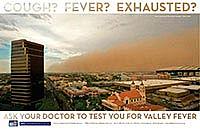Just One Breath: Valley Fever Concerns Spread Out

Image courtesy of the Centers for Disease Control and Prevention
When writing about valley fever for our Just One Breath series, the Reporting on Health Collaborative journalists focused on the San Joaquin Valley.
Most of the people who contract the disease every year in California live there or in Arizona. But concerns about valley fever are starting to spread -- with journalists reporting on the disease from other parts of the country.
CBS Evening News ran an interesting piece about valley fever last month, taking a lot of cues from the Just One Breath series. The story was not centered in any of the San Joaquin Valley cities but, instead, in Paso Robles, where they interviewed one of the valley fever survivors profiled in Just One Breath. Ben Tracy reported:
The long drought is easing in much of the country, but not west of the Mississippi, where it is still bone dry, according to a report … by the federal government. That may be a factor in the spike in valley fever, a little-known illness that is spread by dust in the air. It's often misdiagnosed, and there is no cure.
Deirdre Kennedy at California HealthLine has put together a broadcast piece centered in Ventura.
Most of California's reported cases have been in hot dry areas like the Central Valley and southern California. But Ventura County health officer Robert Levin says it's a mistake to assume that the so-called "cocci" spores are rare in coastal counties like San Luis Obispo, Los Angeles, Orange and Ventura – where cases have been on the rise. "It is endemic here. It's believed by some people though, based on very little information, that the further you get to the actual coastline, the less intense the presence of cocci in the soil."
And Tina Jensen at KRQE in Albuquerque wrote N.M. ripe for spread of valley fever.
It’s a flu-like disease that, in severe cases, can last weeks or months.
“Those that have symptoms that are more flu-like. The difference is, you'll get over flu,” said Dr. Roderick McVeety, medical director of the ABQ Health Partners Urgent Care in Rio Rancho. “This will keep hanging on and on.”
The CDC reports 97% of all cases were in California or Arizona, but New Mexico’s climate makes a perfect storm for the fungus to travel around the region.
“This is an area where we have much more dust because of the dryness, and the spore travels in that dust,” he said.
Valley fever is likely going to generate a lot more interest in the months to come. On Monday, a federal judge demanded that the state of California move all prison inmates at risk for catching valley fever from prisons where the fungus that causes the disease is common to prisons where they will not be as prone to infection. At the Los Angeles Times, Paige St. John wrote:
The order late Monday by U.S. District Judge Thelton Henderson gives the state seven days to begin the transfers and 90 days to complete them. Several thousand inmates, including African Americans, Filipinos and those with diabetes and HIV, are covered by the order affecting Pleasant Valley and Avenal state prisons.
The federal prison system had to pay an inmate $425,000 last year for damages caused when he caught valley fever. These suits are likely to spread, just like the disease. In addition, moving the inmates will cause a squeeze an already overburdened state prison system. I’ll write more about that in a future post.
